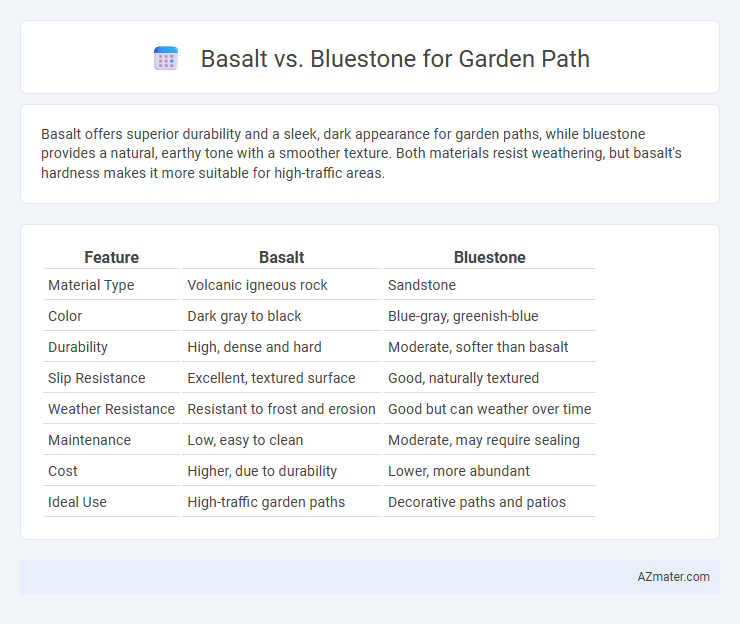Basalt offers superior durability and a sleek, dark appearance for garden paths, while bluestone provides a natural, earthy tone with a smoother texture. Both materials resist weathering, but basalt's hardness makes it more suitable for high-traffic areas.
Table of Comparison
| Feature | Basalt | Bluestone |
|---|---|---|
| Material Type | Volcanic igneous rock | Sandstone |
| Color | Dark gray to black | Blue-gray, greenish-blue |
| Durability | High, dense and hard | Moderate, softer than basalt |
| Slip Resistance | Excellent, textured surface | Good, naturally textured |
| Weather Resistance | Resistant to frost and erosion | Good but can weather over time |
| Maintenance | Low, easy to clean | Moderate, may require sealing |
| Cost | Higher, due to durability | Lower, more abundant |
| Ideal Use | High-traffic garden paths | Decorative paths and patios |
Introduction to Basalt and Bluestone for Garden Paths
Basalt and bluestone are popular natural stone choices for garden paths due to their durability and aesthetic appeal. Basalt is a dense, volcanic igneous rock known for its dark, uniform color and smooth texture, making it ideal for modern and minimalist garden designs. Bluestone, a type of sandstone or limestone with a blue-gray hue, offers a more textured surface and earthy tone that complements rustic and traditional garden styles.
Key Characteristics of Basalt
Basalt is a dense, volcanic igneous rock known for its durability and dark gray to black color, making it ideal for long-lasting garden paths. Its fine-grained texture provides a smooth, slip-resistant surface that withstands heavy foot traffic and various weather conditions. The stone's natural hardness and low porosity contribute to its resistance against wear, fading, and staining in outdoor landscaping applications.
Key Characteristics of Bluestone
Bluestone is a dense, durable natural stone known for its fine-grained texture and range of blue-gray hues, making it ideal for garden paths that require both aesthetic appeal and long-lasting performance. Its slip-resistant surface and ability to withstand varying weather conditions contribute to safety and durability in outdoor landscaping. Bluestone's ease of cutting into consistent shapes allows for precise installation and a polished, uniform appearance in garden pathways.
Aesthetic Appeal: Visual Differences
Basalt offers a sleek, dark gray to black appearance with a smooth, matte finish that creates a modern and elegant garden path. Bluestone showcases a more varied color palette, including blue, gray, and sometimes hints of purple, often featuring a textured, flamed surface that adds natural rustic charm. The visual contrast between basalt's uniformity and bluestone's color variation allows gardeners to select a path material tailored to contemporary or traditional landscape aesthetics.
Durability and Longevity Comparison
Basalt offers exceptional durability and resistance to weathering, making it ideal for garden paths exposed to heavy foot traffic and harsh climates. Bluestone, while also durable, tends to be softer and more prone to chipping or surface wear over time compared to basalt. In terms of longevity, basalt typically outperforms bluestone, retaining its structural integrity and appearance for decades with minimal maintenance.
Slip Resistance and Safety Considerations
Basalt offers excellent slip resistance due to its dense, textured surface, making it a safer choice for garden paths in wet or icy conditions. Bluestone, while visually appealing, tends to be smoother and may become slippery when wet, requiring additional treatments or finishes to enhance safety. When prioritizing slip resistance and safety, basalt typically provides more reliable traction, reducing the risk of slips and falls in outdoor garden pathways.
Climate Suitability and Weather Resistance
Basalt offers excellent weather resistance, making it ideal for regions with extreme temperature fluctuations and heavy rainfall due to its dense composition and low porosity. Bluestone performs well in moderate climates and maintains durability under freeze-thaw conditions but may be more prone to surface erosion in harsh weather environments. Both stones provide natural slip resistance, yet basalt's superior hardness enhances its longevity for garden paths in variable climatic zones.
Installation and Maintenance Requirements
Basalt offers a denser, smoother surface that requires professional cutting tools for precise installation, ensuring a sleek garden path with minimal gaps. Bluestone, being softer and easier to cut, allows for simpler installation with basic tools but demands more frequent sealing to prevent weathering and staining. Maintenance for basalt is generally lower due to its hardness and resistance to chipping, while bluestone benefits from regular cleaning and resealing to maintain its color and structural integrity.
Cost Comparison: Basalt vs Bluestone
Basalt garden paths typically cost more per square foot than bluestone due to its durability and unique volcanic texture, averaging $15 to $30 compared to bluestone's $10 to $25 range. Installation costs for basalt can also be higher because its hardness makes cutting and shaping more labor-intensive, increasing overall project expenses. Bluestone offers a more budget-friendly option with moderate longevity and easier workability, making it attractive for cost-conscious garden path projects.
Choosing the Right Stone for Your Garden Path
Basalt offers a durable, dark-hued option that enhances garden paths with natural elegance and superior weather resistance, making it ideal for high-traffic areas. Bluestone provides a softer, warmer color palette with a smoother texture, perfectly suited for creating inviting, visually appealing walkways in diverse landscaping styles. Selecting the right stone depends on factors like climate resilience, maintenance requirements, aesthetic preferences, and budget to ensure a functional and beautiful garden path.

Infographic: Basalt vs Bluestone for Garden Path
 azmater.com
azmater.com